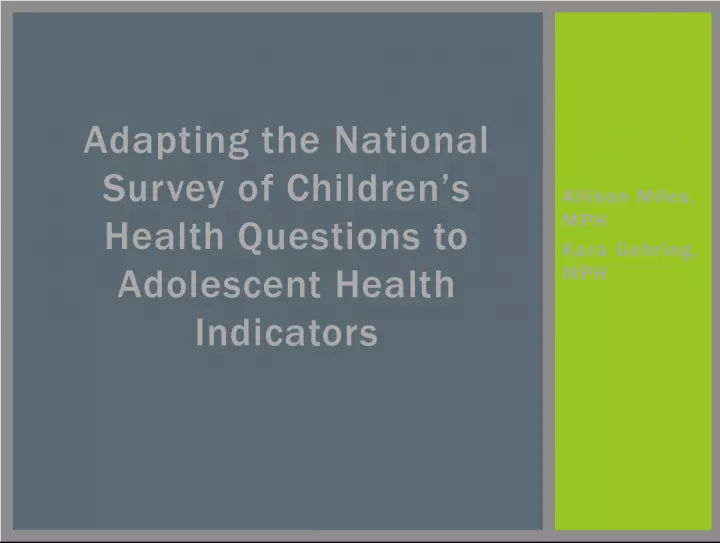Adapting National Survey of Children's Health for Adolescent Health Indicators


Investing in adolescent health leads to immediate and lifelong health improvements with potential to prevent chronic diseases, improve reproductive health, and enhance population birth outcomes.
- Uploaded on | 2 Views
-
 juliarhodes
juliarhodes
About Adapting National Survey of Children's Health for Adolescent Health Indicators
PowerPoint presentation about 'Adapting National Survey of Children's Health for Adolescent Health Indicators'. This presentation describes the topic on Investing in adolescent health leads to immediate and lifelong health improvements with potential to prevent chronic diseases, improve reproductive health, and enhance population birth outcomes.. The key topics included in this slideshow are . Download this presentation absolutely free.
Presentation Transcript
Slide1Allison Miles,MPH Kara Gehring, MPH Adapting the National Survey of Children’s Health Questions to Adolescent Health Indicators
Slide2WHY SHOULD WE BEINTERESTED IN ADOLESCENT HEALTH?
Slide3Immediate impact and health improvements Potential for improved health throughout the lifetime Prevention of cumulative ‘insults’ from communicable diseases, chronic diseases, behavioral/mental health and wellness Acquisition of health ‘assets’ Potential for improving reproductive health WHY INVEST IN ADOLESCENT HEALTH? Adolescent public health investments hold the greatest potential for improving birth outcomes within a population.
Slide4Adolescence is a key period for: Addressing physical, mental, emotional and reproductive health Preventing injuries, transmission of communicable diseases, and chronic substance misuse At least 70% of premature adult deaths reflect behaviors started or reinforced during adolescence. Evidence-based investments in healthy adolescent development have enormous potential for impacting future global health. INVESTING IN ADOLESCENT HEALTH IS ESSENTIAL…
Slide5WHAT DATA SOURCESARE AVAILABLE FOR THE ADOLESCENT POPULATION?
Slide6Local health departments can obtain information about their populations’ health by Using public data Using state and/or local or internal data Conducting survey or community health assessment POPULATION HEALTH SURVEILLANCE
Slide7Youth Risk Behavior Surveillance System— YRBSS National Survey of Children’s Health— NSCH National Survey of Children with Special Health Care Needs— NS-CSHCN Various Local and State-Level Surveillance
Slide8WHAT INDICATORS AREUSED TO MEASURE YOUTH HEALTH?
Slide9Provide a glimpse of a populations health, health risks, or assets Many sets of indicators Chronic Disease Indicators Core State Preconception Health Indicators Life Course Indicators Healthy People 2020 HEALTH INDICATORS For adolescents, there is not an agreed- upon set of indicators.
Slide10CAFICOMMUNITY ADOLESCENT FUTURES INITIATIVE
Slide11Community Adolescent Futures Initiative (CAFI) 6 pilot communities (local health departments) 1 year Using NSCH data and combination of state/local data 3 Pillars 1) Community Engagement 2) Analytic Methods 3) Evidence-Based Interventions CAFI PILOT PROJECT
Slide12METHODS
Slide13Chronic Disease IndicatorsPreconception Health Indicators Life Course Indicators Healthy People 2020 Relevant NSCH Questions Literature
Slide14DATA ANALYSIS
Slide152007, 2011/2012 NSCH data National level HRSA region 7 states 15 local health departments
Slide16RESULTS
Slide1740 Adolescent Health Indicators Six domains Social determinants of health Health care access/utilization Health status Flourishing characteristics and adverse childhood events Household and environmental characteristics School engagement and extracurricular activities ADOLESCENT HEALTH INDICATORS
Slide18Maternal education Highest level of education in the household Poverty (200% below FPL) Working poor household Unemployment Single parent household Residential mobility SOCIAL DETERMINANTS OF HEALTH
Slide19Health care coverage Medical home Preventive care Mental health Unmet health care needs HEALTH CARE ACCESS AND UTILIZATION
Slide20Physical health Dental health Chronic diseases Anxiety and depression Overweight/obesity Physical activity Sleep HEALTH CARE STATUS
Slide21Flourishing Parental stress Adverse childhood events FLOURISHING CHARACTERISTICS AND ADVERSE CHILDHOOD EVENTS
Slide22Tobacco exposure Family involvement Neighborhood characteristics and school safety HOUSEHOLD AND ENVIRONMENTAL CHARACTERISTICS
Slide23School engagement Extracurricular activities Mentors Television and electronic device use SCHOOL ENGAGEMENT, MENTORS, AND EXTRACURRICULAR ACTIVITIES
Slide24DEVELOPINGADOLESCENT HEALTH INDICATORS AT THE LOCAL LEVEL
Slide25Is there sufficient data at the local level to justify this indicator? Is the indicator relevant to adolescent health and/or well-being? Does the indicator have the potential to impact population health? Does the indicator have the potential to impact health across the lifespan? Does the indicator have the potential to impact reproductive health? Are there differences in equity when this indicator is examined by measures of race/ethnicity, education, etc.? Does the indicator serve as a proxy for a social determinant of health? Are the outcomes measured by the indicator modifiable?
Slide26DOES THIS PROCESSWORK AT THE LOCAL LEVEL?
Slide27Small numbersMissing data Selecting the best indicator Reference population
Slide28LIMITATIONS
Slide29Parent/guardian report Missing key questions on adolescent risk behaviors Sexual behaviors Alcohol and substance use Remote access 50:50 rounding technique Small numbers Weighted for states, not localities Not conducted annually (slow turn around) CHALLENGES WITH NSCH DATA Aggregation Synthetic Estimates Confidence Intervals
Slide30Questions